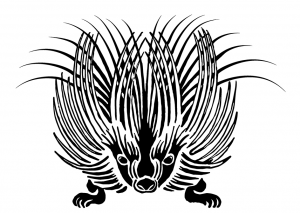Edith is named after Edith Lees Ellis, the writer, social campaigner and women’s rights activist. Edith Lees had several relationships with women and was married to British sexual scientist Havelock Ellis. In his autobiography My Life, Ellis writes about his wife: “No one could be less like a feather bed than Edith; I was sometimes made to feel that she was more like a little porcupine.”
Like Ellis, Sigmund Freud thought porcupines illustrated perfectly the difficulties of achieving and sustaining intimacy. On his desk in Vienna, among his wide-ranging collection of ancient objects, Freud proudly displayed a bronze porcupine, which had been given to him by American neurologist and psychologist James Jackson Putnam. Freud had met Putnam at one of the introductory lectures on psychoanalysis he delivered at Clark University in the United States in 1909. Putnam was fascinated with Freud’s work and even took him on a hike with Carl Gustav Jung to visit a porcupine lair.
The sexological obsession with porcupines does not end here. Alfred Kinsey, an entomologist by training and later Professor of Zoology, was particularly interested in the mating rituals of porcupines. Film footage studied by Kinsey and his colleagues survives at the Kinsey Institute in Bloomington, Indiana. Anthropologist Paul Gebhard, who directed the Institute after Kinsey’s death, would use such footage of animals mating to desensitize budding students of sexual science. One of them, a young man called John M. Gottman, reported that it was the “male porcupine [that] really made an impression”.
Edith will accompany us as we develop our project over the next years. She reminds us of some of our core research questions: whose contributions and which forms of knowledge do we need to include as we aim to rethink the history of sexology? What role did women like Edith Lees Ellis and other contributors without medical credentials play in shaping sexual science? And how can we best understand the ways in which sexual scientists drew on evidence from diverse disciplines and fields, including biology and zoology as well as material culture and anthropology?

